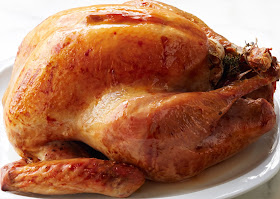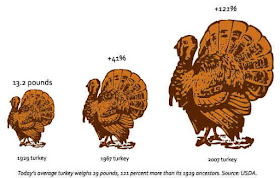When it comes to feeding a crowd, having too much food is always better than having too little. And if you are like most home cooks who slaved over a full turkey dinner and you want to enjoy the fruits of your labor with enough leftover turkey for sandwiches, stews, soups, and potpies.
There are a number of things to consider when buying a turkey. Think about how many people are you serving? From here you should consider how many adults versus children, whether they are light or heavy eaters, and whether or not you want leftovers. These will all help you determine how big of a turkey you need to buy.
Remember these quick guidelines when deciding what size turkey to buy for your dinner and about how much turkey each guest will eat.
This should be enough to cover dinner and allow for leftovers to snack on throughout the evening and for leftover recipes the succeeding days. If you really, really like leftovers and are perfectly content to eat turkey sandwiches, then 1.5 pounds is a good measure.
What is the Correct Turkey Size to Buy?
Here are some figures to keep in mind when you are thinking of how large a turkey you need to buy:
Uncooked whole unstuffed turkey: Think of about two pounds of the entire turkey per person for a small gathering (4 to 8 people), and about 1.5 pounds of the entire, larger turkey per person for a larger group (10 to 16).
Take Note: The larger the bird, the higher the meat-to-bone ratio. For smaller birds -- 12 pounds or less -- have a smaller meat-to-bone ratio, so allow 2 pounds per person.
Uncooked turkey breast (with bone): Think of about 1.25 (one and 1/4 pounds) per person.
Uncooked turkey breast (boneless): Think of about 0.75 pounds (3/4 of a pound) per person.
|
2-2.5kg
|
serves 4-6 people
|
|
3kg
|
serves 6-7 people
|
|
3.5kg
|
serves 7-8 people
|
|
4-4.5kg
|
serves 8-10 people
|
|
5-5.5kg
|
serves 10-12 people
|
|
6-6.5kg
|
serves 12-15 people
|
What Kind of Turkey Should You Buy?
Basted or Self-basting. These are whole birds that are injected with or marinated in a solution that, according to United States Department of Agriculture (USDA) specifications, includes "butter or other edible fat, broth, stock or water; plus spices, flavor enhancers and other approved substances." This increases the moisture content in the meat; however, it also masks the natural taste of the bird.
Organic Turkey. An organic turkey is a turkey that has not been treated with antibiotics, and that has eaten only feed that was itself grown organically, with no chemical processing. The label is not in itself a guarantee of better taste. But as with a free-range turkey, there are good odds an organic one will taste better than the frozen old toms they hand out for free at the local used-car lot. These birds tend to be more expensive, but are potentially the finest and fullest flavored available.
Free-Range Turkey. A free-range turkey conjures images of birds frolicking in open fields. That is not the case. Free-range, in the matter of poultry, means that the birds are shunted out of their pens into an open common area for a certain number of minutes a day, where they court illness before returning to their feed. That feed may or may not contain antibiotics. This increased mobility helps to develop muscle, contributing to a more fully flavored and complex meat. A free-range bird will probably taste better than a non-free-range bird. But the adjective is not the reason: “free-range” is a marketing term that has little to do with the quality or flavor of the meat it describes. Look for the adjective in conjunction with another: a free-range kosher turkey, for instance, or a free-range organic one.
Fresh Turkey. Fresh, in the nomenclature of poultry sales, means unfrozen—it denotes a bird that has been brought right to the edge of frozen, without the flesh going solid in the cold. You will find fresh turkeys in butcher shops and farmer’s markets—they are often the sort of birds that you need to call in advance to reserve, and that are significantly more expensive than your factory-farmed frozen bird. For the administration of a proper Thanksgiving, Christmas dinner or Easter, a fresh turkey is generally the bird that you want. It is more likely, though by no means is it guaranteed, that a fresh turkey will have better flavor than his cousin deep in the supermarket freezer bin.
Frozen Supermarket Turkey. The archetype Thanksgiving and Christmas protein is a frozen turkey purchased from the supermarket. Maybe this turkey grew up in paradise and was dispatched with love. More likely, however, the bird was raised and processed on a crowded industrial factory farm, bred to grow into adulthood as quickly as possible, and fed antibiotics to keep it healthy along the way. Flash-frozen to 0 degrees, it may have been warehoused for some time in advance of the Thanksgiving or Christmas holiday.
Heritage Turkey. The most common commercial strain of turkey in the United States is the Broad Breasted White. It could hardly exist in nature. Its huge chest and relatively tiny legs combine to create a situation in which it cannot breed without human assistance. (Sounds delicious, no?) Increasingly, however, farmers are breeding older “heritage” strains of turkey—Bourbon Reds, Narragansetts, and Bronzes among them—that recall the shape and flavors of turkeys that our forebears consumed. These are leaner birds, in the main, with more dark leg and thigh meat and correspondingly less breast meat than their more popular cousins. They take well to brine, and make for an excellent Christmas or Thanksgiving dinner centerpiece.
Kosher Turkey. Kosher turkeys are free-range, grain-fed birds whose processing is supervised by a rabbi, which leads to some additional cost to the consumer. They receive no antibiotics along the way from birth to death. Because they are salted as part of the koshering process, a kind of dry brine, they generally provide juicy meat and the flesh is denser. And proving that there is no rule without an exception, a frozen kosher turkey is no terrible thing to buy, so long as you allow enough time for the meat to thaw. These birds, also prized for their full taste, tend to be more expensive than non-kosher poultry.
Natural. Can be added to a label if no artificial flavors, colorings, ingredients, chemical preservatives or any other artificial or synthetic ingredients were used to process the meat. Natural poultry can have antibiotics as part of their regime. Poultry labeled "natural" should not be confused with organic. Sometimes "no hormones" will be added to the label; this is a meaningless distinction, since hormones are never used in poultry or egg production in the U.S.
Related Post: Do you know... What is Cooking Loss in Meat?
Are You Going to Purchase Fresh or Frozen Turkey?
Frozen turkeys are generally better value, but if you are a perfectionist, or are looking for a particular breed, go for fresh. Choosing a fresh or frozen turkey depends largely on preference, but also on how soon you plan on cooking your turkey. Make the right decision for you by considering these general tips.
1) Fresh turkeys require no thawing.
2) Frozen turkeys can be purchased weeks in advance, but need several days to thaw and require adequate space in your freezer and refrigerator.
3) Allow 1 day of thawing for every 4 pounds of turkey. NOTE: Turkeys need to be thawed in the refrigerator or by cold water thawing.
How Long You Are Going to Thaw a Frozen Turkey
Here are some numbers to keep in mind when you are thawing a turkey:
Weight: 2.25kg - Thaw in fridge 27 hrs - Thaw in cool room 9 hrs
Weight: 3-3.5kg - Thaw in fridge 42 hrs - Thaw in cool room 12-14 hrs
Weight: 4.5-5.5kg - Thaw in fridge 66 hrs - Thaw in cool room 18-22 hrs
Weight: 6.75-7.5kg - Thaw in fridge 90 hrs - Thaw in cool room 27-30 hrs
A Better Turkey Roasting...
Right, you have bought your bird, now what? Essential information on how to brine, How to Brine a Turkey- Easy Turkey Brine Recipes.
References:
Editors of Fine Cooking. 2012. Fine Cooking Thanksgiving Cookbook: Recipes for Turkey and All the Trimmings. Taunton Press. ISBN-10: 1600858279
Rick Rodgers. 2007. Thanksgiving 101: Celebrate America's Favorite Holiday with America's Thanksgiving Expert (Holidays 101). William Morrow Cookbooks. ISBN-10: 0061227315
Sam Sifton. 2012. Thanksgiving. Random House. ISBN-10: 1400069912
Try this healthy recipe for your special dinner; get it NOW, Creamy Broccoli- Parmesan Soup - The Food Lab Recipes


No comments:
Post a Comment